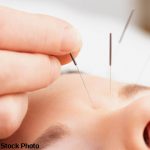A similar conclusion was reached by a systematic review of acupuncture for OA of the knee and hip.15 Twelve of the trials analyzed included only people with OA of the knee, three trials included only those with OA of the hip, and one trial included a mix of hip and knee OA. They concluded that “Sham-controlled trials show statistically significant benefits; however, these benefits are small, do not meet our predefined thresholds for clinical relevance, and are probably due at least partially to placebo effects from incomplete blinding.”
TABLE 2: Methodological Problems in Acupuncture Clinical Trials
- Variety of sham acupuncture procedures used
- Lack of randomization of patients to experimental groups
- Lack of blinding of patient allocation
- Failure to monitor acupuncturist–patient interactions
In addition to the absence of a sham acupuncture control, there are other methodological problems that complicate interpretation of acupuncture trials (see Table 2). Patient–provider interaction is an important variable in placebo-controlled trials.14,16 In the trial by Suarez-Amazor et al, acupuncturists were trained to interact with patients in a manner that conveyed high or neutral expectations of benefit from the treatment.7 Acupuncturists who conveyed high expectations had a small but statistically significant effect on patients’ pain reduction and satisfaction. Some traditional acupuncturists who participated in a trial that included sham acupuncture expressed discomfort with the perceived deception of patients.17 The acupuncturists’ discomfort may have unintentionally sent negative signals to patients. In most trials, there is no indication that patient–acupuncturist interactions were monitored. Other limitations of acupuncture trials include lack of randomization and inadequate concealment of allocation.18 Madsen et al reported that patient allocation was adequately concealed in only 8 of 13 trials.14 Another concern is the lack of information in some trials about the adequacy of blinding (i.e., whether patients were able to distinguish traditional from sham acupuncture).
TABLE 3: Issues to Consider When Counseling Patients About Acupuncture for Relief of Pain
- Current evidence suggests that acupuncture is a placebo treatment
- Efficacy: Approximately 50% of patients will experience relief of pain, and the magnitude of the relief is variable
- Adverse effects: Local adverse effects are usually minor, but acupuncturists may recommend potentially toxic herbal remedies
- Cost: A treatment course may cost $600–$1,200 and may not be covered by insurance
- Are the patient’s options for conventional treatment limited by comorbid health conditions?
In summary, the preponderance of current evidence indicates that TCA is no more effective than a variety of sham acupuncture procedures in relieving low back pain or knee pain caused by OA.
Is Acupuncture a Placebo Treatment?
The question of whether acupuncture analgesia is a placebo effect has to be considered in light of new knowledge of placebo effects and a reconceptualization of the meaning of placebo. The traditional definition of a placebo as a substance or treatment that is inert and lacks specific activity is inadequate to describe the complexity and variety of placebo effects.19-22 Placebo effects, such as the relief of pain, result from a number of factors, including conditioning and the expectations, beliefs, and desires of patients. A useful formulation of placebo effects, termed contextual healing, is, “that aspect of healing that is produced, activated, or enhanced by the context of the clinical encounter, as distinct from the specific efficacy of treatment interventions.”16 In that sense, placebo effects are an integral part of all encounters between patients and healthcare providers, and not merely deceptive practices. The mechanisms of placebo analgesia include activation of endogenous opioid and nonopioid control mechanisms, and alteration of central processing of pain.19,20

